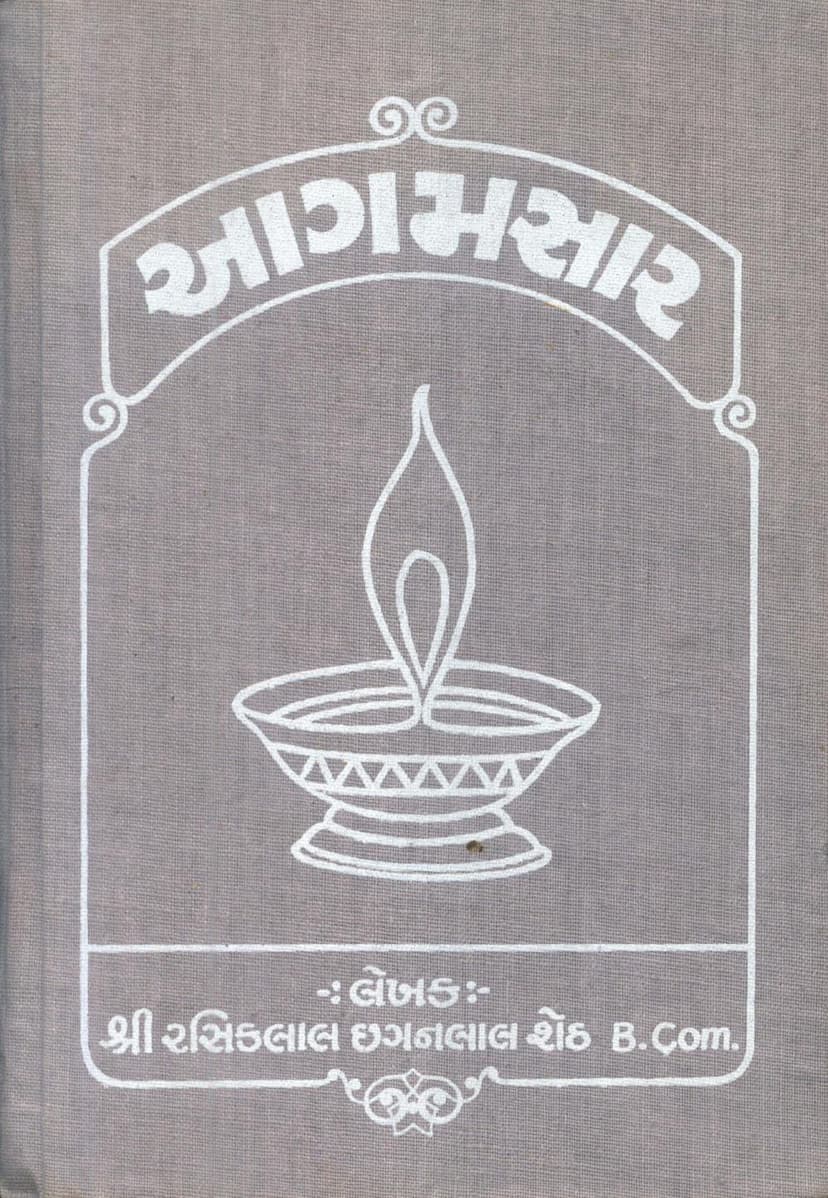Agamsar
Added to library: September 1, 2025

Summary
The book "Agamsar" by Rasiklal C. Sheth, published by Natwarlal C. Sheth, is a comprehensive Jain text that serves as an introduction to the Agams, the sacred scriptures of Jainism. The book is presented in Gujarati and is dedicated to the author's parents, Chhaganlal Chaturbhai Sheth and Dahibai Chhaganlal Sheth.
The primary purpose of "Agamsar" is to elucidate the essence and teachings of the Jain Agams, providing a foundational understanding for readers interested in Jain philosophy and practices. The author emphasizes the authenticity and validity of the Agams, which are considered the true words of the omniscient Tirthankaras.
Here's a breakdown of the key themes and content covered in the book, as per the provided pages:
Introduction and Dedication:
- The book is authored by Rasiklal C. Sheth and published by Natwarlal C. Sheth.
- It is dedicated to the author's parents, Chhaganlal Chaturbhai Sheth and Dahibai Chhaganlal Sheth, as a way to express gratitude and acknowledge their spiritual influence.
- A strong emphasis is placed on respecting the scriptures and preventing any form of disrespect or degradation of the Jain religious texts.
Core Concepts of Jainism and the Agams:
- Vitaraag (Tīrthaṅkaras) are Truthful: The book asserts that the Tirthankaras, who have attained the state of being free from attachment and aversion, speak the absolute truth. Their teachings, the Jinavāṇī (Jain scriptures), are presented as the ultimate guide for spiritual upliftment.
- Authenticity of Jinavāṇī: The scriptures are deemed correct and the ultimate source of spiritual knowledge.
- Agam (Scripture): The text delves into the derivation and meaning of the word "Agam," highlighting its connection to "gati" (movement or attainment) and "A" (prefix indicating completeness or perfection), signifying the complete knowledge of reality.
- Purpose of Agams: The primary goal of the Agams is to promote "Jīvadayā" (compassion towards all living beings) and to guide souls towards spiritual liberation (moksha).
- Language of the Agams: The Agams are primarily written in Ardhamagadhi, the language spoken by the Tirthankaras, which is considered to be divinely inspired and universally understandable.
- Agam as an Inexhaustible Treasure: The scriptures are described as an unfathomable ocean of knowledge, encompassing spiritual insights, scientific truths (like the nature of atoms, cosmos), history, karma theory, and ethical principles.
- The Twelve Angas (Dvadashāṅgī): A significant portion of the text is dedicated to outlining and explaining the Twelve Angas, the core scriptures of Jainism. These are presented as the body of the Śrutapuruṣa (embodiment of scriptural knowledge). The book lists and briefly describes each of the Twelve Angas, starting with Āchārāṅga Sūtra and ending with Dṛṣṭivāda Sūtra (though the latter is noted as lost). It also mentions the Twelve Upangas, Four Mūlasūtras, and Four Chedasūtras.
- Classification of Agams: The text discusses the classification of scriptures into "Anga" (primary) and "Bahya" (secondary), along with the division of scriptures into Mūlasūtras and Chedasūtras. It also touches upon the historical context of the Agams, including their compilation and the eventual loss of some parts due to the decline of memory power over time.
- Importance of Study and Practice: The book stresses the significance of studying the Agams and following their teachings for self-realization and liberation. It encourages the reader to delve into the spiritual knowledge contained within the scriptures for their own welfare.
- Adhyātma (Self-Realization): Adhyatma, the knowledge of the soul, is presented as the core of Jainism. The book explains that through self-inquiry and spiritual practices, one can understand the true nature of the soul and its journey from the material world to liberation.
- Anekāntavāda (Multidimensionality): While not explicitly detailed in the provided pages, the underlying principle of Anekāntavāda, which is central to Jainism, is implicitly present in the comprehensive and systematic presentation of knowledge.
- Support and Acknowledgement: The book acknowledges the contributions of various individuals and organizations who supported its publication, highlighting the collective effort in spreading Jain knowledge.
- Corrections (Śuddhipatraka): A section for errata is included, indicating a meticulous approach to presenting the information accurately.
- Author's Other Works: A list of other books by Rasiklal C. Sheth is provided, showcasing his dedication to Jain literature.
- Future Publications: The author expresses intentions for future publications, including a Jain philosophical lexicon and a commentary on the Āvaśyaka Sūtra.
Detailed Structure of the Agams (as outlined in the index and descriptions): The book meticulously lists and describes the following categories of Jain scriptures:
-
Twelve Angas (Mūlasūtras):
- Āchārāṅga Sūtra (covering conduct and discipline)
- Sūyagaḍāṅga (Sūtra-kṛtāṅga) (dealing with philosophical and ethical doctrines)
- Sthānāṅga Sūtra (discussing categories and places)
- Samavāyāṅga Sūtra (dealing with classifications and groupings)
- Vivāha Prajñapti (Bhagavatī Sūtra) (a vast encyclopedic work)
- Jñātādharmakathāṅga Sūtra (narrating stories of the virtuous)
- Upāsakadashāṅga Sūtra (describing the conduct of lay followers)
- Antagaḍadaśāṅga (Antagaḍadaśā’o) (on ascetics reaching liberation)
- Anuttaraupapātika (on beings in highest heavens)
- Praśnavyākaraṇa Sūtra (dealing with questions and answers)
- Vipākasūtra (on the fruits of karma)
- Dṛṣṭivāda Sūtra (considered lost, dealing with philosophical views)
-
Twelve Upangas: Listed from Uvavāyi Sūtra to Vahidaśā Sūtra.
-
Four Mūlasūtras: Dashavaikālika, Uttarādhyayana, Nandi, and Anu’yogadvāra.
-
Four Chedasūtras: Niśītha, Vyavahāra, Brihatkalpa, and Dashashrutaskandha.
-
Additional scriptures: Mention of Tattvārtha Sūtra.
The provided text offers a detailed summary of each Anga and Upanga, explaining their philosophical and practical significance within the Jain tradition. It highlights the historical context, the meaning of the titles, and the essence of their teachings, particularly focusing on conduct, ethics, karma, soul, and the path to liberation. The latter part of the text goes into great detail about the classification, content, and philosophical nuances of these scriptures, making it a valuable resource for understanding the structure and depth of Jain Agamic literature.
In essence, "Agamsar" serves as a guide, unraveling the profound wisdom contained within the Jain Agams, making it accessible to a wider audience and fostering a deeper appreciation for the Jain way of life.